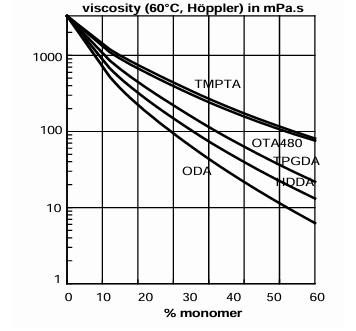Enhanced TDS
Identification & Functionality
- Blend
- No
- CASE Ingredients Functions
- Chemical Family
- Function
- Oligomer, Monomer
- Product Code
- MITM00359
- Single Ingredient
- Yes
- Technologies
- Product Families
Features & Benefits
- CASE Ingredients Features
- Performance Highlights
Ebecryl®1657 is characterized by :
- Low irritancy
- Low odor
- Good pigment wetting
- Outstanding lithographic behavior
UV/EB cured products based on Ebecryl®1657 are characterized by the following performance properties:
- Low extractables
The actual properties of UV/EB cured products also depend on the selection of the other formulation components, such as reactive diluent(s), additives and photoinitiators.
Applications & Uses
- Application Method
- Coating End Applications
- Compatible Substrates & Surfaces
- Cure Method
- Ink & Toner End Applications
- Markets
- Applications
- Product Applications
Formulated UV/EB curable products containing Ebecryl®1657 may be applied by lithographic, screen, gravure, direct or reverse roll, and curtain coating methods.
Ebecryl®1657 is recommended for use in:
- Lithographic inks with low extractability when formulated in conjunction with other purified products and additives
- Coatings on paper, metals and plastics
Properties
- Physical Form
Technical Details & Test Data
- Viscosity Reduction
- Ebecryl®1657 can be diluted with reactive monomers such as trimethylolpropane triacrylate (TMPTA), oligotriacrylate (OTA 480), tripropyleneglycol diacrylate (TPGDA), 1,6 hexanediol diacrylate (HDDA) and octyl/decyl acrylate (ODA).
- The specific reactive diluent(s) used will influence performance properties such as hardness and flexibility.
- Viscosity Reduction vs Concentration of Different Monomers

Safety & Health
- Safety Precautions
- The toxicological properties of this material have not been fully determined.
- Products of this type can be expected to be eye and skin irritant and have the potential to cause sensitization or other allergic responses.
- Appropriate precautions should be taken to avoid eye and skin contact and to avoid inhalation of the aerosols or vapors.
Packaging & Availability
- Packaging Type
Principal Information
- Group Principal Number
- S000001
- Principal
Storage & Handling
- Storage Conditions
- Care should be taken not to expose radiation curable products to temperatures exceeding 40°C for prolonged periods or to direct sunlight.
- This might cause uncontrollable polymerization of the product with generation of heat.
- Storage and handling should be in stainless steel, amber glass, amber polyethylene or baked phenolic lined containers.
- Do not store this material under an oxygen free atmosphere.
- Use dry air to displace material removed from the container.
- This material should not be stored for more than 2 years.
Other
- Appearance (SDS)
- Liquid
- Color (SDS)
- Dark amber
- Item Number
- Odor (SDS)
- Ester acrylate
- Other Hazards
- Polymerization may occur from excessive heat, contamination or exposure to direct sunlight .
- Protect from Freezing
- Yes
- Temperature Control
- Yes
- USA/DOT UN Number
- Not Applicable
- Material Composition
Value Units Test Method / Conditions Solid Content 80.0 %(W/W) %(W/W) - Mechanical Properties
Value Units Test Method / Conditions Tensile Elongation 23.0 % % measured on a 125μ UV cured film Tensile Strength 30.0 MPa MPa measured on a 125μ UV cured film - Physical Properties
Value Units Test Method / Conditions Density 1.17 g/cm³ g/cm³ Molecular Weight 500.0 g/mol g/mol Storage Temperature 39.2-104.0 °F °F - SDS Physical and Chemical Properties
Value Units Test Method / Conditions Boiling Point (SDS) min. 100.0 °C °C Density (SDS) 1.03 g/cm³ g/cm³ Flash Point (SDS) min. 100.0 °C °C Cleveland Open Cup Vapor Pressure (SDS) 0.013 Pa Pa at 25°C Viscosity (SDS) 3000.0-4000.0 mPa.s mPa.s at 60°C Volatile Content (SDS) max. 0.1 % % - Shelf Life & Stability
Value Units Test Method / Conditions Shelf Life 2.0 yr yr
